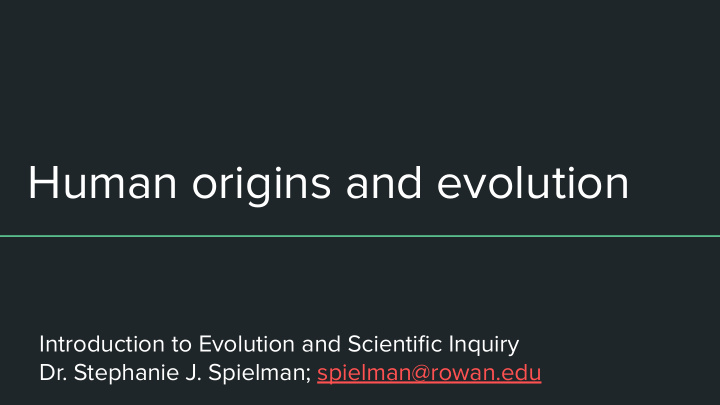



Human origins and evolution Introduction to Evolution and Scientific Inquiry Dr. Stephanie J. Spielman; spielman@rowan.edu
Phylogenetics also shows humans are originally from Africa Modern-day non-Africans Modern-day Africans
Relationship with great apes is under debate, but first is generally preferred
Australopithecus afarensis is among the earliest hominid fossils (3-4 ma) "Lucy" (Ethiopia, 3.2 ma) ● Earliest hominid fossils in sub-Saharan Africa Bipedal like modern humans ● ● Like other apes.. ○ Protruding face ○ Small skull and brain, about size of modern chimp ● Transitionary fossil! ○ "Intermediate" tibia and femur angles
Australopithecus lived throughout east Africa until ~1.5 ma
Lucy used tools!! ● Tools are a hallmark of human cultural evolution and signify intelligence ○ Previous research thought tools originated 1-2 ma ● Who else uses tools? For-fun reading: https://www.livescience.com/9761-10-animals-tools.html ○
Paranthropus robustus (1.5-2 ma) is a likely Australopithecus descendent ● A robust Australopithecus species discovered in South Africa ● Larger skull and thicker bone structure compared to Australopithecus
The Homo genus emerges ~2 ma with Homo habilis
Homo erectus lived ~1.6 ma - 400,000 years ago (recent!!)
Homo erectus ventured out of Africa
"Peking Man" Homo erectus fossils ● Roughly 200 fossils found outside Beijing (Peking) in the 1920s ~200,000-700,000 years ago ● ● Ongoing excavation of site
Origins of modern humans ( Homo sapiens ) Earliest fossil, 315,000 years old..in Morocco?! https://www.nature.com/news/oldest-homo-sapiens-fossil-claim-rewrites-our-species-history-1.22114
Modern humans began to leave Africa as early as 180,000 years ago ● Recent research has uncovered the oldest out-of-Africa fossil in Israel Previously, we thought 100,000 years ago ● Human teeth in China from ~100,000 years ago
Theories for human dispersal "Out of Africa" model Alternative model Several different waves of leaving Initial single migration to Middle ● ● Africa East, and spread from there https://www.nature.com/news/how-china-is-rewriting-the-book-on-human-origins-1.20231#evolution
Homo neanderthalensis lived ~400,000-40,000 years ago
Homo denisova lived during the same time
There was extensive interbreeding among Homo "species"
We see Neanderthal genes in certain human genomes, moreso Asian than European. ~None in Africans = Percent of genome that came from Neaderthals 10.1126/science.aao1887
Homo sapiens interbreeding with Denisovans Admixture = fancy word for interbreeding https://doi.org/10.1016/j.cell.2018.02.031
Neanderthal-Denisovan hybrid discovered last year
Other Homo species only observed outside of Africa https://www.youtube.com/watch?v=MGN2DvDYWgc
Evolution and diversity of modern humans
Human genetic diversity is higher in sub-Saharan Africa Two main reasons: 1. Successive bottlenecks (drift!) 2. Local adaptation to new environments (strong directional selection) Circles = alleles http://www.genetics.org/content/201/1/1
Humans have much more diversity than do ancient (now extinct) species. Implications? Neanderthal-Denisovan hybrid Neanderthal 10.1126/science.aao1887
Tales in local human adaptation 10.1126/science.aad0584
The evolution of lactase persistence (LP) ● Lactose intolerance is an ancestral trait! As children we all digest milk by definition (we are mammals) with the lactase ● enzyme ● Lactose intolerant individuals stop making lactase between ages 2-5 years old. ● Individuals with lactase persistence keep making it, i.e. the lactase enzyme persists after childhood → lactose tolerance – Lactase in mother’s milk breaks down lactose into easily absorbed sugars glucose and galactose. • Lactase expression is lost between the ages of 2 – 5 – Continued production of lactase throug
Who can drink milk? Genomes show DIFFERENT mutations in the same gene allowing for LP! = convergent evolution towards LP in humans
Light-colored skin is also convergently evolved ● Allele frequencies for the light-skin mutation of European populations. ○ Grey in pie chart = European mutation ○ Black in pie chart = Ancestral dark-skin gene These human populations have light skin, but do NOT have the European mutation. https://academic.oup.com/mbe/article/24/3/710/1240790
High altitude populations have convergently adapted Ethiopian Highlands
Recommend
More recommend